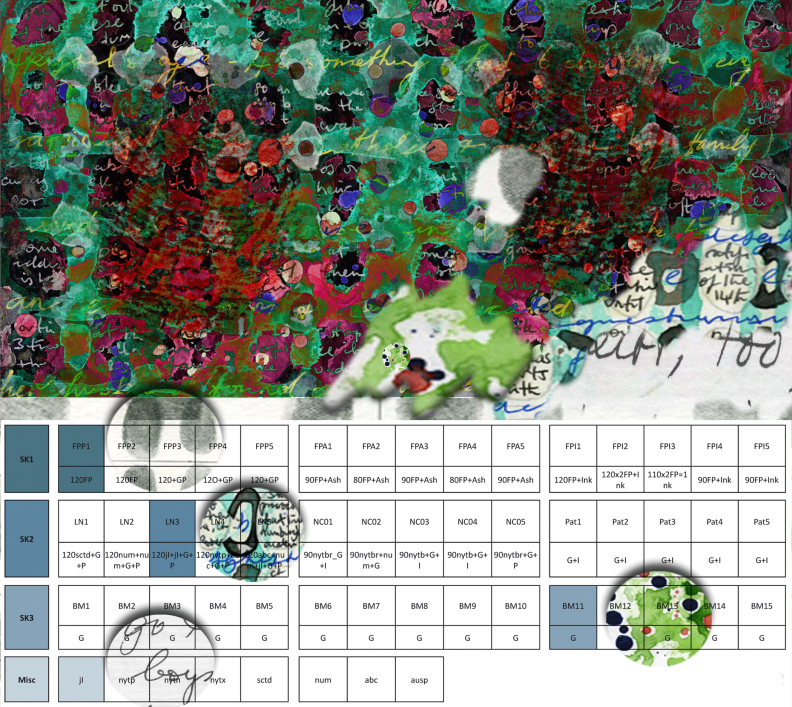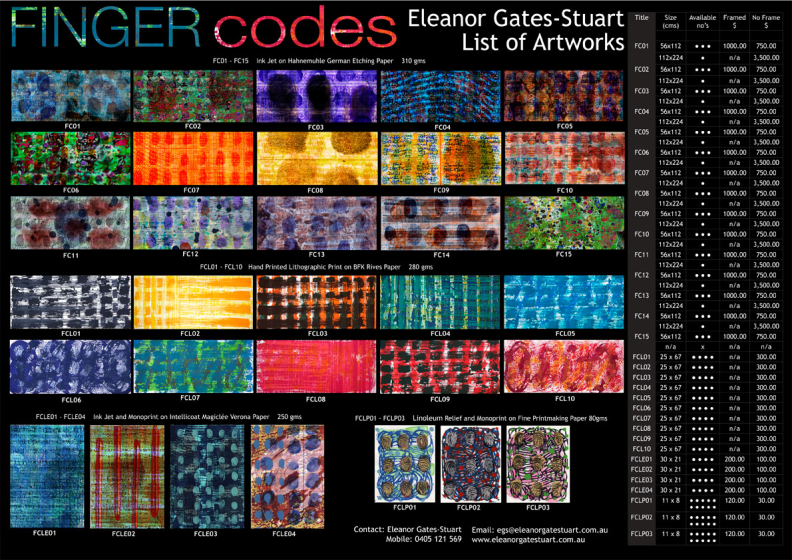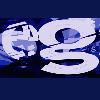FingerCodes: Exploring Identity through Science and Art

"It is all so simple, a fingerprint, an impression of my finger – the printed mark. Black? Blue? Red? … Yes black. The black is so dense and dark, cold and strong and fits well with the definition of a stamp, albeit a life printed".
Human fingerprints are translated into numerical symbols, coded through the artist’s drawings and used as symbolic data. Patterns that merge are also to be lost, woven and undone again, in layers adding complexity in the language of code and information architecture. The artist strives for simple representation, the artworks to appear non-technological and seemingly painterly, a result that belies the underlying infrastructure and composition of this creative endeavour (Gates-Stuart).
Gates-Stuart, E: FingerCodes Exhibition Catalogue.

FingerCodes Collection: FC01-FC15, FCL01-FCL10, FCLE01-FCLE04, FCLP01-FCP03
Author: Eleanor Gates-Stuart
-
International Residency, University of California, Santa Cruz (UCSC) USA, (2010)
-
Public Lecture: ‘FingerCodes’, UCSC
-
Exhibition: ‘FingerCodes’ Sesnon Gallery, USA, 2010
-
Exhibition: ‘Cracking the Code’, CSIRO Discovery Centre, 2011
Publication
-
Gates-Stuart, E., & Wohlfeiler, R. (2011). Finger Codes. IMPRINT: The Journal of the Print Council of Australia, 44(2), 32.
Exhibition: ‘Finger Codes’, Discovery Centre, CSIRO, (2011)
Review
-
Musa, H. (2011). Eleanor Gates-Stuart: Cracking the finger codes. Art Monthly Australia, (145).
-
Wawrzynczak, A. D. (2011, August 11). When art gets to close to science. City News, p. 22. Canberra City News


More information and images available on request
Contributing Texts
Norman Locks, Jimin Lee & Richard Wohlfeiler, University of California Santa Cruz
>>>
V I S I T I N G / B E I N G V I S I T E D
Eleanor’s status and responsibilities as “Visiting Artist” in print media were multiple and layered: teaching students, producing artwork, interacting with UCSC faculty and staff, and having her own experience of Santa Cruz, the campus, and art community. That all of this had to happen in the compressed span of one academic quarter could be productively catalytic or a potential muddle. The personal resources that she brought to the task—I’m thinking of her intellectual engagement and energy, her awareness of and interest in the students as individuals, her accessibility and enjoyment of communication—seem to me to have tipped the experience toward the former. Busy with my classes and spending hours in the print studio to experiment and explore my own projects, I frequently encountered Eleanor there and, over the quarter, we managed to maintain an ongoing series of discussions and conversational exchanges centered on and generated by the complex nature of the place: teaching, learning, art ideas, technical processes, conceptual processes, and the ways in which all of these are involved with the broad activity of making art. I appreciate the genuine engagement she showed in being a “Visitor” in the full social sense, participating energetically in the creative life of the studio and the department during her brief stay here. This dimension of the exchange has hopefully started currents that will continue after she leaves.
P R O C E S S
Seeing Eleanor in the studio several times each week gave me the opportunity to observe the variety of processes she employed on the way to developing her ideas into their final embodiment as prints. In significant ways, it’s a privilege to be able to see an artist’s work evolve and come together, because often our experience of a work of visual art is only in its completed form, which can have the misleading consequence of giving art the identity of a commodity product rather than as a manifestation of a variety of kinds of thinking. By giving importance to chance, intuition, irrationality, enjoyment and feeling, the ways in which the creative activity of visual thinking productively expands the category of “thought” augments the possibilities of conceptual discourse beyond conventional expectations of rationality and conventions of certain logical procedures. Eleanor’s sense of the relationships among concepts and processes is evident through her use of materials and sources and the many transformations, deconstructions, combinations, and recombinations that these undergo as she builds the work. Some of the processes I noticed were manual drawing using both conventional and unconventional materials, scanning to digitize these, manipulation of digitized material in Photoshop through a broad range of transformative possibilities offered by that tool, digital printing, creation of photo litho plates from hand-drawn sources, and multi-plate lithographic color printing. She made extensive use of her opportunities to explore both our digital and traditional facilities in print media.
L A N G U A G E, C O D E S, A N D C O D I N G
The terms “language,” “codes,” and “coding” were central to Eleanor’s projects here, and they came up in every conversation we had about her ongoing work. Her implementation of these concepts took a variety of forms, some of which were readily visible, some wanted closer looking, and some were effectively hidden by process or the complexity of their combination with other forms. Recognizing the traces of such hidden forms usually required the artist’s revelation of sources, which she readily shared; without this artist-supplied information, however, those visually disrupted forms and associations essentially remained private, becoming a type of personal cryptographic coding. Among the kinds of coding she referenced are:
-
fingerprints (identity, security, personal marking)
-
manual manipulation of materials (personal marking, traditions of painting/drawing)
-
analog/digital relationships (mimesis produced by photography and scanning, illusionistic effects, digital image structure, physical textures)
-
texts (typefaces, handwriting): letters, words, sounds, meanings, language (frequently fragmented, these bits of texts raise questions of context and legibility: as the original meanings of the text fragments become difficult to decipher, the possibility for subjective interpretation or association opens up)
-
computer programming language
-
structure as an organizational principle that can be visible or hidden (grids, circles, rows, patterns)
-
layering and strata as an artifact of process to produce a kind of visual coding that elicits a different set of responses, primarily aesthetic (shape, color, pattern, texture, detail, space)
There are undoubtedly others she could tell you about, but approaching the printed images in terms of coding practices highlights aspects of various orders of presenting and reading information visually. Further thinking about this might even lead to attempts to distinguish between “information” and “knowledge”.
Lecturer Richard Wohlfeiler, Print Media
>>>
Mapping Languages
At a time of collapsing specialization, when disciplinary studies slide, dissolving into one another revealing new knowledge Eleanor Gates-Stuart is creating metaphoric landscapes mapping the markings of patterned language samples signing one another. Eleanor Gates-Stuart digital prints illuminate, in variation, data delivered in layered transparent notation.
In the early sketches the first layer printed was the finger print establishing the beginning, recognizing our individual presence, our observations of rivers of characters, numerical, text, blood, microscopic and aerial perspectives. As, within our daily lives, layers of translucent information flow constantly, simultaneous delivery arriving continuously. The fingerprint is a portrait and a graph of our life. Latter evolutions of the image build and suggest varied patterns of thought and understanding.
Each day when I entered the digital studio Visiting Artist Eleanor Gates-Stuart was exploring a new series of marks, and having tested them on paper, she sat transferring them to digital memory. The computer and digital technologies was the perfect tool to suspend and imprint the interwoven conversations. While Eleanor’s final inkjet prints carry the signature of years of art making, looking like a cross between print media and painting, they in fact could not have been created without the computer and associated programs stitching thin pixel layers into streams of information.
Examples of complexity in our lives are endless, particular to our own existence, continually related in our own stories about our history and our experiences. While the details of our histories vary we share being human. Eleanor Gates-Stuart creates panoramas that reflect the natural complexity of our lives and the languages we use to express ourselves. She strives to commit seemingly specialized languages to the same page.
Professor Norman Locks, Chair of Arts
>>>
Finger Coding, by Eleanor Gates-Stuart, is a series of artworks with an implied focus on identity and pattern structures, using fingerprint and data-world information.
Gates-Stuart’s work introduces text and visual references to data-mapping, making use of extensive research in print and digital media. She creates a series of semi-abstract patterns she calls “finger coding,” using fingerprints as a bas structure of images to which she adds numerical data, code, and her own watercolor drawings and sketches. In this way she adds a symbolic overlay upon the basic identity represented by the fingerprint images to create a new identity, text, or pattern.
The resulting prints, as the artist has explained, achieve a kind of aesthetic balance that unifies both systematic and chaotic elements. They also show a fine sense of color and the harmony of serial images. One of the nice things about her work is that she allows the beautiful, subtle marks of watercolor brush strokes to be incorporated into her prints, human marks with the relatively cold digital techniques she uses. This action is really important.
While the fingerprints may be an individual expression of identity, the layering of personal drawings, images, and brush marks creates her own very human identity code. Thus the usual roles are reversed, and, in Gates-Stuart’s work, fingerprints become more an abstract element and the personal marks, drawings, brush strokes, and so on become the true fingerprint.
Associate Professor Jimin Lee, Print Media
>>>
All works on this site must not be reproduced or copied without permission and/or acknowledgement. Contact page for requests.
